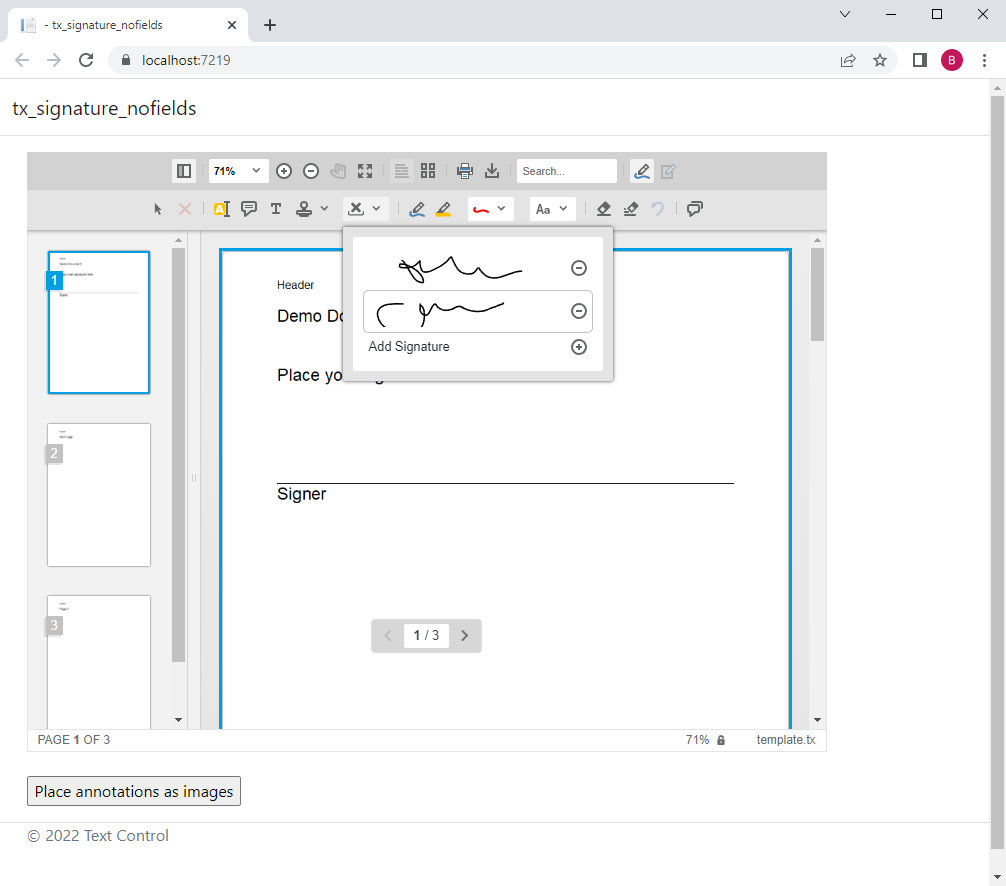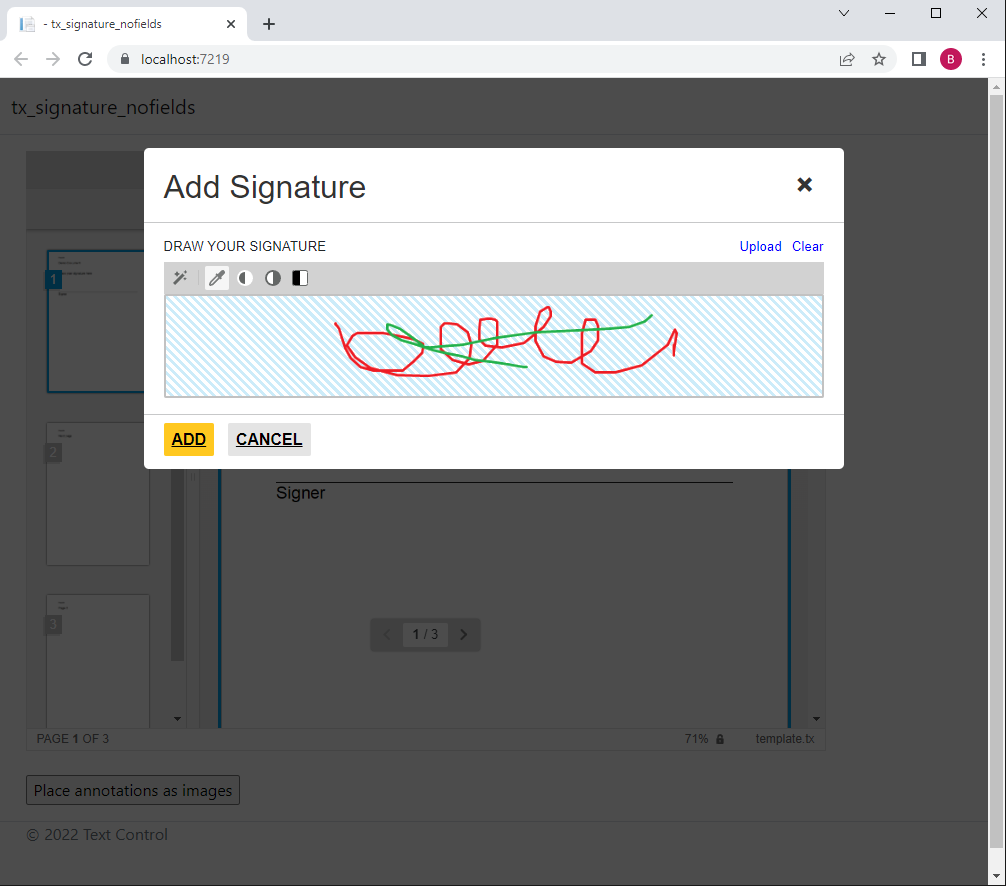Merging Signature Annotations into Documents
The latest version of the TX Text Control Document Viewer can be used to sign any document with an annotation signature. This sample shows how to merge those SVG images into documents server-side.

Using the TX Text Control Document Viewer, electronic signatures can be requested from users to sign a pre-defined signature field. This signature field is then replaced with the acquired signature image and digitally signed using a digital certificate.
Instead of signing pre-defined fields, the latest version of the Document Viewer is able to acquire a signature image from users in order to insert the signature image as an annotation object to the document. Those annotation objects are stored independently from the document and can be retrieved using the annotations.export JavaScript method.
Signature Annotations
Signature annotations can be added using a new button in the annotation toolbar:

Using the signature soft pad, multiple signatures can be drawn or uploaded. Those signatures are stored locally and can be used across sessions:

After placing a signature onto a document, they are part of the annotation collection.

Exporting Annotations
When exporting the annotations as JSON using the annotations.export method, the placed signature is added as an SVG image. In this sample application, this JSON object is being sent to the HttpPost Controller method MergeAnnotations:
function storeAnnotations() {
var annotations = TXDocumentViewer.annotations.export();
var obj = JSON.parse(annotations);
var serviceURL = '@Url.Action("MergeAnnotations", "Home")';
$.ajax({
type: 'POST',
url: serviceURL,
contentType: 'application/json',
dataType: 'json',
data: JSON.stringify(obj),
success: successFunc,
error: errorFunc
});
function successFunc(data, status) {
TXDocumentViewer.loadDocument(data.data, 'results.tx');
}
function errorFunc() {
alert('error');
}
}Inserting Annotations as Images
Server-side, the array of Annotation arrays is received as Annotation objects defined through the following model:
public class Location {
public double x { get; set; }
public double y { get; set; }
}
public class Pen {
public string type { get; set; }
public double objectWidth { get; set; }
public double objectHeight { get; set; }
}
public class Annotation {
public Pen pen { get; set; }
public string user { get; set; }
public Location location { get; set; }
public long time { get; set; }
public List<Comment> comments { get; set; }
public string id { get; set; }
public string image { get; set; }
}
public class Comment {
public string comment { get; set; }
public List<string> user { get; set; }
public long date { get; set; }
public string id { get; set; }
public string status { get; set; }
}In the controller method, the SVG signature image representation of each annotation is used to create a new Image object from a MemoryStream. Finally, the image is added to the document at the given location and page number.
[HttpPost]
public string MergeAnnotations() {
Stream inputStream = Request.InputStream;
inputStream.Position = 0;
StreamReader str = new StreamReader(inputStream);
string sBuf = str.ReadToEndAsync().Result;
List<List<TXTextControl.SignatureAnnotation.Annotation>> annotations =
JsonConvert.DeserializeObject<List<List<TXTextControl.SignatureAnnotation.Annotation>>>(sBuf);
byte[] bTx;
int iPageNumber = 0;
string prePng = "data:image/png;base64,";
string preSvg = "data:image/svg+xml;utf8,";
// calculate the current resolution
var dpi = 1440 / DocumentController.DpiX;
// create temporary ServerTextControl
using (ServerTextControl tx = new ServerTextControl()) {
tx.Create();
// load the document
tx.Load(Server.MapPath("~/App_Data/Documents/template_sign.tx"), StreamType.InternalUnicodeFormat);
// loop through the array of annotations
foreach (List<TXTextControl.SignatureAnnotation.Annotation> pages in annotations) {
iPageNumber++;
foreach (TXTextControl.SignatureAnnotation.Annotation annotation in pages) {
// handle only signatures
if (annotation.pen.type != "signature")
continue;
byte[] bytes;
// get SVG or PNG as bytes and remove the prefix
if (annotation.image.StartsWith(prePng))
bytes = Convert.FromBase64String(annotation.image.Remove(0, prePng.Length));
else
bytes = Encoding.UTF8.GetBytes(annotation.image.Remove(0, preSvg.Length));
// create a memory stream from SVG
using (MemoryStream ms = new MemoryStream(
bytes, 0, bytes.Length, writable: false, publiclyVisible: true)) {
// TX image from memory stream
TXTextControl.Image img = new TXTextControl.Image(ms);
// add the image as a fixed object on the current page (array)
tx.Images.Add(
img,
iPageNumber,
new System.Drawing.Point(0, (int)(annotation.location.y * dpi)),
TXTextControl.ImageInsertionMode.BelowTheText | TXTextControl.ImageInsertionMode.FixedOnPage);
// set the location
img.Location = new System.Drawing.Point(
(int)(annotation.location.x * dpi),
img.Location.Y);
}
}
}
// save the document as PDF
tx.Save(out bTx, TXTextControl.BinaryStreamType.InternalUnicodeFormat);
}
// return as base64 encoded string
return Convert.ToBase64String(bTx);
}After all images have been added, the document is saved and returned to the client. This way, those signature annotations can be also embedded into PDF documents.
Also See
This post references the following in the documentation:
- Javascript: Annotations.export Method
- TXText
Control. Image Class
![]()
Download and Fork This Sample on GitHub
We proudly host our sample code on github.com/TextControl.
Please fork and contribute.
Requirements for this sample
- TX Text Control .NET Server 31.0
- Visual Studio 2022
ASP.NET
Integrate document processing into your applications to create documents such as PDFs and MS Word documents, including client-side document editing, viewing, and electronic signatures.
- Angular
- Blazor
- React
- JavaScript
- ASP.NET MVC, ASP.NET Core, and WebForms
Related Posts
ASP.NETASP.NET CoreDocument Viewer
High-Performance Text Replacement in Large DOCX Files using C# .NET
Learn how to efficiently replace text in large DOCX files using C# .NET and the ServerTextControl component from Text Control. This article demonstrates the performance benefits of using the…
ASP.NETASP.NET CoreDocument Viewer
Document Viewer 33.2.1 Released: New Event and Bug Fixes
This service pack includes important bug fixes and improvements to enhance the stability and performance of the Document Viewer. In addition, a new event has been introduced to provide developers…
Building an ASP.NET Core Backend (Linux and Windows) for the Document Editor…
This article shows how to create a backend for the Document Editor and Viewer using ASP.NET Core. The backend can be hosted on Windows and Linux and can be used in Blazor, Angular, JavaScript, and…
Using the Document Editor in SPA Applications using the removeFromDom Method
This article shows how to use the removeFromDom method to remove the Document Editor from the DOM when it is no longer needed. This is useful when the Document Editor is used in a Single Page…
ASP.NETASP.NET CoreDocument Viewer
Document Viewer: Long Polling Support for Loading Documents
The Document Viewer now supports long polling for loading documents. This allows an asynchronous loading of documents and is especially useful for large documents or slow connections.






